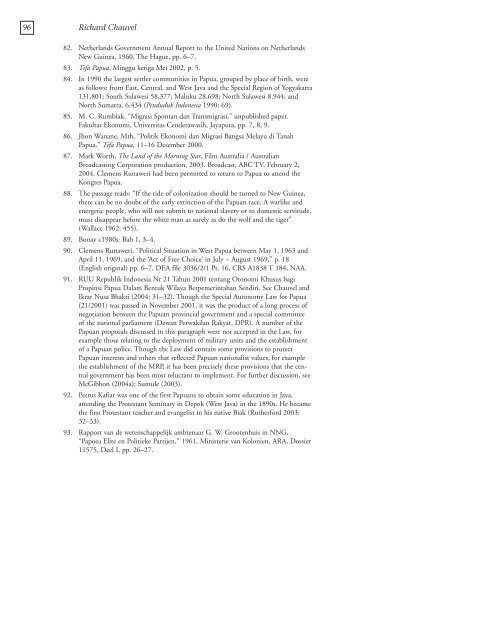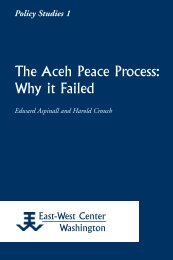Constructing Papuan Nationalism: History, Ethnicity ... - ScholarSpace
Constructing Papuan Nationalism: History, Ethnicity ... - ScholarSpace
Constructing Papuan Nationalism: History, Ethnicity ... - ScholarSpace
- No tags were found...
You also want an ePaper? Increase the reach of your titles
YUMPU automatically turns print PDFs into web optimized ePapers that Google loves.
96 Richard Chauvel82. Netherlands Government Annual Report to the United Nations on NetherlandsNew Guinea, 1960, The Hague, pp. 6–7.83. Tifa Papua, Minggu ketiga Mei 2002, p. 5.84. In 1990 the largest settler communities in Papua, grouped by place of birth, wereas follows: from East, Central, and West Java and the Special Region of Yogyakarta131,801; South Sulawesi 58,377; Maluku 28,698; North Sulawesi 8,944; andNorth Sumatra, 6,434 (Penduduk Indonesia 1990: 69).85. M. C. Rumbiak, “Migrasi Spontan dan Transmigrasi,” unpublished paper.Fakultas Ekonomi, Universitas Cenderawasih, Jayapura, pp. 7, 8, 9.86. Jhon Wanane, Mth, “Politik Ekonomi dan Migrasi Bangsa Melayu di TanahPapua.” Tifa Papua, 11–16 Desember 2000.87. Mark Worth, The Land of the Morning Star, Film Australia / AustralianBroadcasting Corporation production, 2003. Broadcast, ABC TV, February 2,2004. Clemens Runaweri had been permitted to return to Papua to attend theKongres Papua.88. The passage reads: “If the tide of colonization should be turned to New Guinea,there can be no doubt of the early extinction of the <strong>Papuan</strong> race. A warlike andenergetic people, who will not submit to national slavery or to domestic servitude,must disappear before the white man as surely as do the wolf and the tiger”(Wallace 1962: 455).89. Bonay c1980s: Bab 1, 3–4.90. Clemens Runaweri, “Political Situation in West Papua between May 1, 1963 andApril 11, 1969, and the ‘Act of Free Choice’ in July – August 1969,” p. 18(English original) pp. 6–7. DEA file 3036/2/1 Pt. 16, CRS A1838 T 184, NAA.91. RUU Republik Indonesia Nr 21 Tahun 2001 tentang Otonomi Khusus bagiPropinsi Papua Dalam Bentuk Wilaya Berpemerintahan Sendiri. See Chauvel andIkrar Nusa Bhakti (2004: 31–32). Though the Special Autonomy Law for Papua(21/2001) was passed in November 2001, it was the product of a long process ofnegotiation between the <strong>Papuan</strong> provincial government and a special committeeof the national parliament (Dewan Perwakilan Rakyat, DPR). A number of the<strong>Papuan</strong> proposals discussed in this paragraph were not accepted in the Law, forexample those relating to the deployment of military units and the establishmentof a <strong>Papuan</strong> police. Though the Law did contain some provisions to protect<strong>Papuan</strong> interests and others that reflected <strong>Papuan</strong> nationalist values, for examplethe establishment of the MRP, it has been precisely these provisions that the centralgovernment has been most reluctant to implement. For further discussion, seeMcGibbon (2004a); Sumule (2003).92. Petrus Kafiar was one of the first <strong>Papuan</strong>s to obtain some education in Java,attending the Protestant Seminary in Depok (West Java) in the 1890s. He becamethe first Protestant teacher and evangelist in his native Biak (Rutherford 2003:32–33).93. Rapport van de wetenschappelijk ambtenaar G. W. Grootenhuis in NNG,“Papoea Elite en Politieke Partijen,” 1961, Ministerie van Kolonien, ARA, Dossier11575, Deel I, pp. 26–27.
















